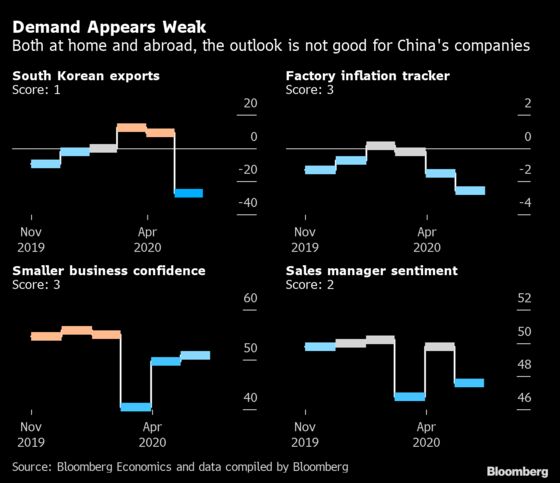China’s Second-Quarter Rebound Already Losing Steam, Data Show
China’s nascent rebound from the historic contraction in the first quarter is already losing pace in April.
(Bloomberg) --
China’s nascent rebound from the historic contraction in the first quarter is already losing pace in April, amid signs of a global recession and still weak domestic demand.
While March data showed a pickup from the slump in the first two months of the year, the earliest indicators for this month show domestic demand as still very weak and companies remaining cautious.

The aggregate index combining eight indicators tracked by Bloomberg was therefore broadly unchanged this month. While the fact that it didn’t deteriorate signals a possible bottoming-out of the economy as the nation re-opens factories and encourages the public to return to shopping and dining out, the overall picture is still downbeat.

Small business confidence rose slightly after March’s strong rebound, but the pace of increase slowed, and a gauge of expectations dropped after gaining the previous month.
“Despite an improvement in real activity, uncertainty about the recovery has increased on growing headwinds from a likely global recession” in the current quarter, according to a report from Standard Chartered economists Shen Lan and Ding Shuang, who survey smaller firms. “Sales remain sluggish, largely dragged down by a drop in export orders due to a rapid deterioration in external demand.”
The indicator for new orders rose to 49.4, while that for new export orders began contracting again, dropping sharply to 41 from 50.8. A number under 50 indicates contraction.
Data from Japan and South Korea indicates how weak that demand is. South Korean exports in the first 20 days of April plummeted the most since 2009, when the world was mired in the financial crisis. Its economy contracted in the first quarter and the outlook for global trade means that weakness may continue.
And Japan, another major trading parter for China, is in an even worse position. Its economy was already shrinking late last year and that’s forecast to continue all year, with the slump in global demand compounding domestic weakness.
The problem facing China now is that it’s mostly back in business, but the global shutdown has caused clients and orders to disappear, according to a survey of sales managers by World Economics.
In the first quarter, there were orders but not production capacity, and now there’s capacity but no orders, one sales manager was reported as saying.
That weak demand and plummeting oil prices is dragging factory prices deeper into deflation, with Bloomberg’s producer price tracker at the lowest level since mid-2016. That slump will hurt the profits of many companies and thus damage investment and hiring.

The central bank and government have stepped up support for financial markets in the past month, cutting interest rates and releasing funding to banks to lend more. However, the stock market has lost momentum, with the 3% rise in the CSI index of 300 companies listed in Shanghai and Shenzhen well below major U.S. benchmarks.
Iron ore futures in China fell more than 2% this week, paring a rebound in April amid caution around demand prospects this year. Any demand boost from infrastructure will be offset by weaker growth in the property sector, top steelmaker Hesteel Co. said. Copper also wavered, with the metal dropping for the first week in four in Shanghai.
Note on Early Indicator construction
Bloomberg Economics generates the overall activity reading by aggregating the three-month weighted average of the monthly changes of eight indicators, which are based on business surveys or market prices.
- Major onshore stocks - CSI 300 index of A-share stocks listed in Shanghai or Shenzhen
- Key property stocks - All the constituents of CSI 300 Index that are in the real estate industry
- Iron ore prices - Spot price of iron ore for shipment to Qingdao port (dollar/metric tonne)
- Copper prices - Spot price for refined copper in Shanghai market (yuan/metric tonne)
- South Korean exports - South Korean exports in the first 20 days of each month
- Factory inflation tracker - Bloomberg Economics created tracker for Chinese producer prices
- Small and medium-sized business confidence - Survey of companies conducted by Standard Chartered Bank
- Sales manager sentiment - Survey of sales managers in Chinese companies by World Economics Ltd.
©2020 Bloomberg L.P.
With assistance from Bloomberg